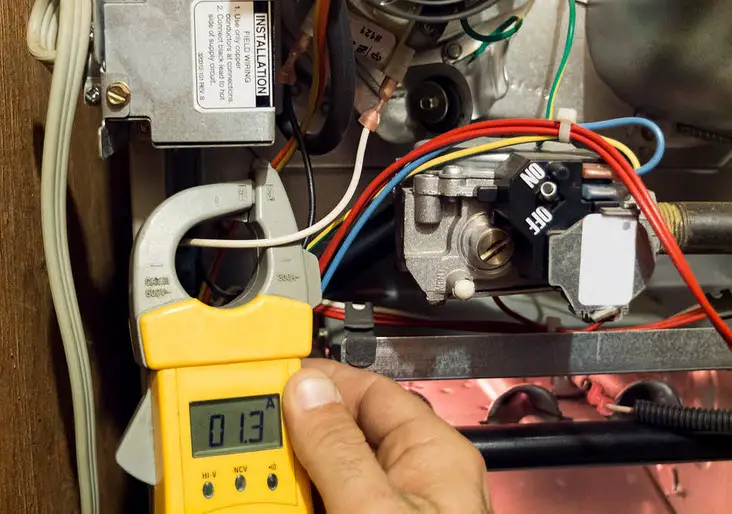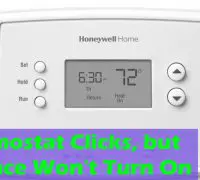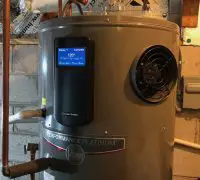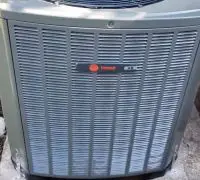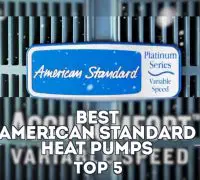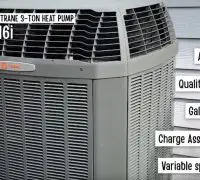Furnaces are excellent devices that keep our houses’ temperature comfortable, no matter how hot or cold it gets outside. They come with intricate mechanisms and are highly sophisticated, so troubleshooting is quite challenging most of the time.
As furnaces have to run and stop continuously, they are exposed to intense wear, so issues may always occur. The variety of problems that the furnace may develop is just as impressive. They overcome the inexperienced customer, no matter how interested in solving the problem independently he/she may be.
Blower fan not stopping, furnace unable to ignite, or funny noises are some of the numerous problems your furnace could develop. Sometimes, everything may look okay with your furnace; it starts as it should, the blower fan stops after a while, whereas the furnace manages to ignite. However, there’s still one big problem: the furnace doesn’t heat the air enough, so you instead feel lukewarm coming throughout the house.
Page Table of Contents
What causes the air to be lukewarm instead of hot?
Even if many of the furnace’s issues request help from the professionals, not all problems are significant. Sometimes, the problems are elementary, and the fixes are easy. Several issues could make the furnace generate lukewarm and not hot air, so keep reading for the details:
The thermostat is set to “on”
It’s probably the most common reason and the easiest to fix for which the furnace doesn’t heat the air properly. The thermostat is set to “on,” making the furnace run continuously, even if it doesn’t heat the air anymore, generating a lukewarm attitude.
What’s the fix?
You need to check the thermostat and set it to “auto.” It’s the easiest fix that makes the fan run only when your furnace is heating.
Issues with the flame sensor/thermocouple
When there’s an issue with the flame sensor or the thermocouple, the furnace won’t ignite the burners. It’s not very complicated to observe if the furnace is igniting the burners or not.
When the furnace doesn’t light, a defective or dirty flame sensor/thermocouple could generate the problem.
What’s the fix?
DIY homeowners can take the plunge and clean the flame sensor. Replacing the flame sensor is necessary after some time as the sensors wear out after some time. As long as you’re following the user manual and feel confident enough, cleaning or replacing the thermocouple/flame sensor isn’t the most complicated task when fixing the furnace.
Most homeowners will feel more confident calling the professionals for investigations and fixing.
The filter could be the cause
When the airflow to the furnace is blocked in any way, the furnace burner could turn off while the blower keeps operating. Therefore, the air will feel lukewarm and even cold after some time.
Dirty air filters, a too restrictive filter (1 and 2-inch filters are common causes), and improper installation of the filter (backward) are the most common reasons the air filter could restrict the airflow of lukewarm air running in the house.
What’s the fix?
Air filters require cleaning and replacing at least once a year for proper performance. Needless to say, you should install them correctly so that they sustain the furnace’s activity and not cause lukewarm air.
Is it a high-efficiency, two-stage model?
A high-efficiency, the two-stage furnace is made to operate for a longer time, turning on and off less often than counterparts. They are just as effective as your vehicle is when driving on the highway instead of stop-and-go traffic. As a high-efficiency model will reach the lower heating stage, it’s somewhat expected that the air is rather lukewarm and not hot.
What’s the fix?
It’s not a problem per se, so there is no fixing required. However, you may check that everything is fine with your furnace by increasing the temperature on the thermostat to see if the air becomes warmer or not.
Some of the air ducts are leaking
Leaky air ducts could also make the air rather lukewarm and not hot, as it’s supposed to be. Keep in mind that almost all home will leak around 30% of the ducts’ air, so it’s not a problem to avoid altogether. Cold air will come inside the ductwork, so even if the furnace produces hot air, you will only feel it lukewarm.
What’s the fix?
You will need to identify the leaking ducts, which isn’t always an effortless job. Should you have the skills and experience, you should address the leaking ducts. Sealing the leaking ducts should solve the problem.
You have issues with the gas supply
When the furnace doesn’t receive gas or not enough gas, it will not heat as intense as it should. Checking the gas supply is one of the steps to take when you have lukewarm and not hot air in the house. Is the gas turned off? Does the gas company experience any problems?
You will have to take a look at your furnace when turning on. When the burners do ignite and produce heat, you don’t have a problem with the gas supply. The flame sensor or the thermocouple could stop the furnace from properly heating, causing lukewarm air.
What’s the fix?
You always have to make sure that the gas valve to the household is turned on. Should the furnace have some problems with the gas inside, you will have to ask for professional help.
Do you have a gas furnace?
If you’ve moved recently to a new house, you may not be completely aware of the heating system you have in the household. Even if gas furnaces are very popular, electric heat pumps are standard too. If that’s the case for you, the air coming out of the vents isn’t as hot as expected or as hot as gas furnaces will produce.
A heat pump will commonly generate hot air of 90-100 F degrees, whereas furnaces will generate hot air with temperature ranging from 120 to 125F degrees.
What’s the fix?
Once again, you’re not dealing with a problem; it’s widespread for a heat pump to generate lukewarm air and not hot air (or not as hot as gas furnaces will generate). You shouldn’t stress about having a problem with the heating system if you have a heat pump, and the thermostat reaches the set temperature every single time. It’s how hot the air will get with the heat pump.
